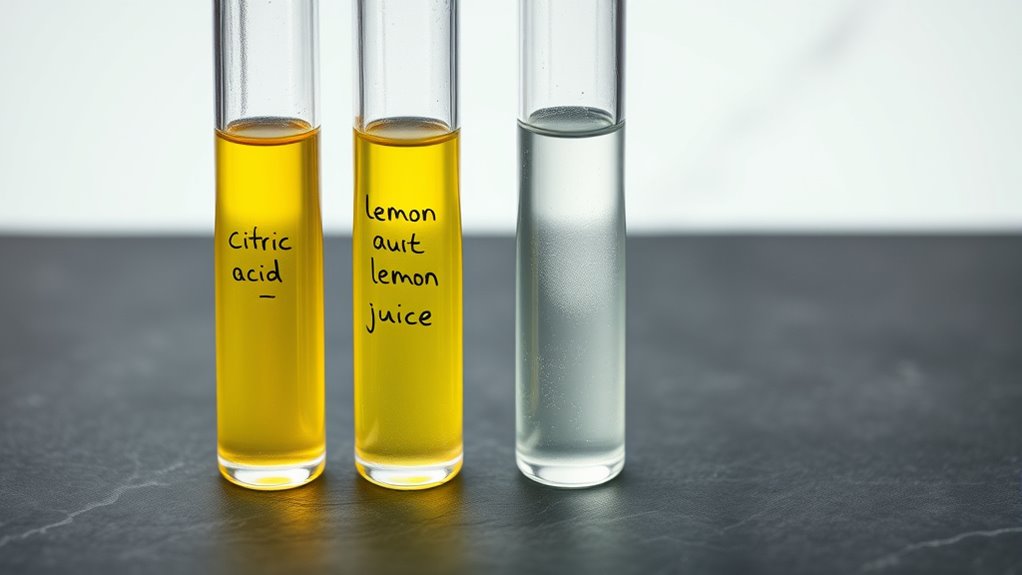To achieve silky hummus, aim for a pH between 4.5 and 5, whether you’re using lemon juice or citric acid. Lemon juice adds brightness and natural flavor, but you’ll need to add it gradually and taste along the way. Citric acid offers more precise control without affecting flavor. Both can help you reach that perfect texture, and staying within this pH range makes your hummus irresistibly smooth. Keep going to discover how to fine-tune this balance even more.
Key Takeaways
- The ideal pH range for silky hummus is approximately 4.5 to 5, regardless of whether you use citric acid or lemon juice.
- Lemon juice naturally contributes to a brighter flavor but can vary in acidity; citric acid offers precise pH control.
- Adding acidity gradually and tasting frequently ensures the pH stays within the optimal range for smoothness.
- Citric acid allows for more consistent pH adjustments without altering flavor, unlike lemon juice, which adds citrus notes.
- Achieving the correct pH enhances hummus texture and flavor, making both options effective when used properly.

Achieving perfectly silky hummus depends largely on controlling its pH level, which influences texture and smoothness. When you focus on pH adjustment, you’re essentially fine-tuning the acidity to reveal that creamy, velvety consistency everyone loves. But beyond texture, acidity also plays a crucial role in flavor enhancement. The right level of acidity can brighten the hummus, balancing the earthiness of chickpeas with a fresh tang that elevates the overall taste.
Controlling pH enhances hummus texture and brightens flavor with a balanced, silky finish.
Many home cooks and chefs rely on lemon juice or citric acid to achieve this delicate pH balance. Lemon juice is a natural choice, offering a bright, citrusy flavor that pairs beautifully with the nutty taste of tahini. Its acidity not only enhances flavor but also helps break down chickpeas, making them easier to blend into a smooth paste. However, because lemon juice contains natural sugars and other compounds, it can slightly alter the flavor profile if overused. To keep things balanced, start with a small squeeze and taste as you go, gradually increasing until you find that perfect tang.
Citric acid, on the other hand, offers a more precise pH adjustment. It’s a concentrated, pure form of acidity that allows you to control the pH level more accurately. If your goal is to achieve a silky texture without adding extra liquid or altering flavor too much, citric acid can be a game-changer. Just a tiny pinch dissolved in water can lower the pH enough to improve smoothness and consistency. Keep in mind, though, that citric acid has a more neutral flavor compared to lemon juice, so you won’t get that fresh citrus note—it’s purely for pH regulation and flavor enhancement.
Choosing between lemon juice and citric acid depends on your desired flavor profile and how precise you want to be with pH adjustment. Lemon juice brings vibrancy and natural brightness, elevating the hummus’s flavor, while citric acid offers a cleaner, more controlled approach to acidity. Both methods can help you achieve that ideal pH range, usually around 4.5 to 5, which is essential for silky texture and balanced flavor. Remember, the key is to add acidity gradually, tasting along the way, so you don’t overpower the delicate balance of flavors or compromise smoothness. With a little experimentation, you’ll find the perfect pH level that makes your hummus irresistibly creamy and flavorful every time. Additionally, understanding the best free keto diet app can help you maintain a healthy lifestyle that complements your culinary skills.
Frequently Asked Questions
Can Adding Citric Acid Affect Hummus Flavor Differently Than Lemon Juice?
Adding citric acid can impact your hummus differently than lemon juice. Citric acid provides a more concentrated flavor, leading to sharper flavor enhancement and consistent acidity. It also helps with texture modification, making the hummus silkier and smoother. Lemon juice offers a fresher, more complex flavor and natural acidity, which might create a brighter taste. So, your choice influences both flavor enhancement and texture, shaping your hummus’s overall profile.
How Does Ph Influence Hummus Shelf Life and Safety?
You should know that pH influences hummus shelf life and safety by maintaining proper pH levels, which help inhibit microbial growth. When you control pH effectively, you extend freshness and reduce spoilage risks. Acidic environments, achieved with ingredients like lemon juice or citric acid, promote microbial inhibition, ensuring your hummus stays safe longer. Proper pH maintenance is essential for both quality and safety in homemade or commercial hummus.
Are There Other Acidic Ingredients That Improve Hummus Texture?
Imagine your hummus as a silky river flowing smoothly; other acidic ingredients can be your secret tributaries that enhance this flow. You might try vinegar or tamarind, which serve as alternative thickening agents and natural preservative options. These acids not only improve texture but also extend shelf life. Experimenting with these can transform your hummus into a luscious, velvety masterpiece that stays fresh longer, delighting every dip and spread.
Is There a Risk of Over-Acidifying Hummus With Citric Acid?
You might wonder if adding too much citric acid risks over-acidifying your hummus. Excessive acid levels can disrupt the pH balance, making it too tangy or affecting the texture. To keep it silky, add citric acid gradually, tasting as you go. Carefully monitoring acid levels guarantees you maintain the right pH balance, preventing over-acidification while achieving that perfect creamy consistency.
How Can I Measure the Ph Level of My Hummus Accurately?
To measure your hummus’s pH accurately, start with a reliable pH meter. Guarantee proper pH calibration using standard buffer solutions before testing. Dip the electrode into your hummus, wait for the reading to stabilize, and record the pH level. Regular calibration and gentle cleaning of the electrode help maintain accuracy, so you can confidently adjust acidity to achieve silky, well-balanced hummus every time.
Conclusion
Now that you know the secret pH range for silky hummus, you’ll realize how small tweaks can make a big difference. Whether you choose citric acid or lemon juice, mastering the balance guarantees your hummus turns out perfectly smooth and flavorful. Remember, it’s often the little things that make all the difference, so don’t be afraid to experiment within that ideal pH window. With a bit of practice, you’ll have hummus that’s truly worth its weight in gold.










